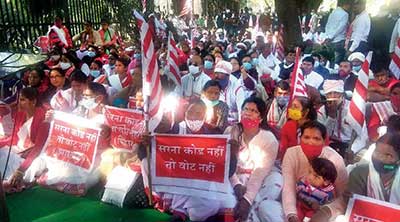Relevance: GS-2: Indian Constitution- historical underpinnings, evolution, features, amendments, significant provisions, and basic structure.
Key Phrases: Santhali Population, Sarna Religious Code, NDA's Presidential Nominee, Traditional Way of Life, Indigenous Communities, Constitutional safeguards, Right to Freedom of Religion, Scheduled Tribes
Why in News?
- One of the candidates for the next Presidential polls is a tribal woman.
- This has brought tribal issues under the spotlight.
- With this, the long-standing demand to recognise “Sarna” as a separate religion of indigenous communities is gaining traction.
About NDA’s Presidential Nominee: Droupadi Murmu:
- Murmu, a native of the Mayurbhanj district of Odisha, began her career as a teacher before going into state politics.
- She was elected as an MLA in the Odisha Assembly in 2000 from the constituency of Rairangpur which comes under the Mayurbhanj parliamentary seat.
- Murmu was inaugurated as Jharkhand's first female governor in 2015.
Santhali Population:
- The Santhali population is distributed in Odisha, Jharkhand and West Bengal.
- Draupadi Murmu's home district Mayurbhanj, is one of the districts having the largest concentrations of the tribe.
- In Odisha, Santhals are found in Keonjhar and Balasore, other than the Mayurbhanj district.
- Their literacy rate is very high compared to other tribes in Odisha.
- Murmu’s election will be beneficial for the whole Santhal community.
Scheduled Tribes
- Article 366 (25) defined scheduled tribes as "such tribes or tribal communities or parts of or groups within such tribes or tribal communities as are deemed under Article 342 to be Scheduled Tribes for the purposes of this constitution".
- Article 342: The President may, with respect to any State or Union territory, and where it is a state, after consultation with the Governor thereof by public notification, specify the tribes or tribal communities or parts of or groups within tribes or tribal communities which shall, for the purposes of this constitution, are deemed to be scheduled tribes in relation to that State or Union Territory, as the case may be.
- Parliament may by law include in or exclude from the list of Scheduled tribes any tribe or tribal community or part of or group within any tribe or tribal community.
- Thus, the first specification of Scheduled Tribes in relation to a particular State/ Union Territory is by a notified order of the President, after consultation with the State governments concerned. These orders can be modified subsequently only through an Act of Parliament.
- The above article also provides for listing of scheduled tribes State/Union Territory-wise and not on an all-India basis.
- The criterion followed for specification of a community, as scheduled tribes are primitive traits, distinctive culture, geographical isolation, shyness of contact with the community at large, and backwardness.
- The tribal communities in India have been recognized by the Indian Constitution under ‘Schedule 5’ of the constitution.
- Hence, the tribes recognized by the Constitution are known as ‘Scheduled Tribes’.
Constitutional Safeguards for Scheduled Tribes:
- Educational & Cultural Safeguards:
- Art. 15(4):- Special provisions for the advancement of other backward classes (which includes STs).
- Art. 29:- Protection of Interests of Minorities (which includes STs).
- Art. 46:- The State shall promote, with special care, the educational and economic interests of the weaker sections of the people, and in particular, of the Scheduled Castes, and the Scheduled Tribes, and shall protect them from social injustice and all forms of exploitation.
- Art. 350:- Right to conserve distinct Language, Script or Culture and instructions in Mother Tongue.
- Social Safeguards:
- Art. 15:- Prohibition of discrimination on grounds of religion, race, caste, sex, or place of birth
- Art. 23:- Prohibition of traffic in human beings and beggars and other similar forms of forced labour.
- Art. 24:- Forbidding Child Labour.
- Economic Safeguards:
- Art. 16:- Equality of opportunity in matters of public employment
- Art. 335:- Claims of Scheduled Castes and Scheduled Tribes to services and posts
- Art. 275:- Grants-in-Aid to specified States covered under Fifth and Sixth Schedules of the Constitution.
- Political Safeguards:
- Art.164(1):- Provides for Tribal Affairs Ministers in Bihar, MP, and Orissa
- Art. 330:- Reservation of seats for STs in Lok Sabha
- Art. 337:- Reservation of seats for STs in State Legislatures
- Art. 334:- 10 years period for reservation.
- Art. 243:- Reservation of seats in Panchayats.
- Art. 371:- Special provisions in respect of the NE States and Sikkim.
- The Implementing Agency for all these safeguards is the National Commission for Scheduled Tribes.
What is Sarna Religion?
- The followers of the faith do not believe in idol worship and instead revere the forces of nature, be it forests, hills, rivers, or land.
- The holy grail of the faith is “Jal, Jungle, Zameen” while believing in protecting the forest areas.
- Jharkhand has 32 tribal groups of which eight are from Particularly Vulnerable Tribal Groups.
- They have been demanding recognition of it as a distinct religion for decades.
- At present, under the census, there are codes for only six religions: Hinduism, Islam, Christianity, Sikhism, Buddhism, and Jainism.
- While filling in these columns, a tribal resident has to identify themselves as one of these or as ‘others’, but cannot specify his / her religion as a different one.
- If the Centre approves the new Sarna code, Census 2021 would have to make space for a new religion.
What is the need for Sarna Code?
- Right to Freedom of Religion:
- It is their fundamental right that their faith also deserves recognition under Article 25 if they can be recognised under Article 342 of the Constitution as Scheduled Tribes.
- The new identity will give them a new dignified life, especially to those who consider themselves as nothing but members of tribal communities.
- Loss of Traditional Way of Life:
- The demand stems from anxieties over losing identity, culture, and the traditional way of life in the absence of formal recognition.
- In the absence of a Sarna code, the followers enlist themselves in the “Other Religions and Persuasion (ORP)” category during the Census exercise.
- Threat of Conversion to other Religions:
- Both Christianity and Hindutva groups (in northeast India) compete to bring the tribal communities under their respective folds.
- Those who still follow the Sarna faith believe the converted tribals are taking the benefits of reservation as a minority as well as the benefits given to Schedule Tribes.
- To resist this, there have been serious attempts to institutionalise the indigenous faith of the respective tribal communities, to create space for their own faith.
- Grant of Constitutional Rights:
- The population of tribals in the state had declined from the 38.3 per cent in 1931 to 26.02 percent in 2011.
- One of the reasons for this was tribals who go for work in different states not being recorded in the Census.
- Also, in other states, they are not counted as Tribals.
- The separate code will ensure the recording of their population.
- The declining numbers affect the constitutional rights given to them and how the rights will be bestowed upon the Adivasis under the 5th Schedule of the Constitution.
- For the Census 2011, the National Commission for Scheduled Tribes did recommend the addition of this code.
- Since all constitutional safeguards and welfare provisions are based on population estimation, they fail to benefit from those measures.
Constitutional Safeguards on Right to Religion:
- The Constitution of India, declares India to be a secular state with no state religion.
- Religious diversity and religious tolerance are established by the law.
- The Constitution of India defines freedom of religion as a fundamental right and holds India to be a secular state.
- Article 25 endows the Right to Religion not only to the citizen but to every person within the territory of India.
- It guarantees to every person the freedom of conscience and the right to freely profess, practice, and propagate the religion of their choice.
- The Right to Religion is a very personal and private right of every individual.
- It’s a matter of faith and belief that drives and guides the moral concepts of a human being. It is a way of life for some, for some worship is very close to the heart.
- Article 25 endows the Right to Religion not only to the citizen but to every person within the territory of India.
Concept of Minority in the Indian Constitution
- While Article 30 and Article 29 of the Constitution do not specify
'minorities' in India, it is classified into religious minorities and
linguistic minorities.
- Religious minorities in India:
- The basic ground for a community to be nominated as a religious minority is the numerical strength of the community.
- For example, in India, Hindus are the majority community.
- As India is a multi-religious country, it becomes important for the government to conserve and protect the religious minorities of the country.
- Section 2, clause (c) of the National Commission of Minorities Act, declares six communities as minority communities. They are Muslims, Christians, Buddhists, Zoroastrians (Parsis), Sikhs, and Jains.
- Linguistic Minorities:
- The class or group of people whose mother language or mother tongue is different from that of the majority groups is known as the linguistic minorities.
- The Constitution of India protects the interest of these linguistic minorities.
- Religious minorities in India:
TMA Pai Case: The SC in the case allowed for the state-wise consideration of religious and linguistic minorities for the purposes of Article 30 which deals with the rights of minorities to establish and administer educational institutions.
Art.29: Protection of Interests of Minorities
- Article 29(1): This provides any section of the citizens residing in India having a distinct culture, language, or script, the right to conserve their culture, language, and script.
- Article 29(2): The State shall not deny admission into educational institutes maintained by it or those that receive aid from it to any person based only on race, religion, caste, language, or any of them.
Art. 30: Right of Minorities to Establish and Administer Educational Institutions
- Article 30(1): All religious and linguistic minorities have the right to establish and administer educational institutions of their choice.
- Article 30(2): The State shall not, when granting aid to educational institutions, discriminate against any educational institution on the ground that it is under the management of a minority, whether based on religion or language.
- In independent India, the tribal identity has been about constitutional provisions promising to protect their rights and central laws promising to protect their land.
- Although Scheduled Tribes are recognised as an administrative and social category, these communities have never been recognised as a separate religious group.
Conclusion:
- Tribal religious belief is an ecological expression of their existence that maintains an intimate relationship with nature.
- When today the entire world is focusing on reducing pollution and protecting the environment, it is prudent that Sarna becomes a religious code as the soul of this religion is to protect nature and the environment.
- Sarna Dharam can teach a lot to the world facing problems, such as pollution and environmental degradation, as it is all about worshipping nature, forests, and mountains.
- India needs to embrace its multiple religious and cultural traditions and this new religious category is about recognising and respecting these differences.
- In the context of the long historical exploitation of Adivasi communities all over India and the marginalisation of their cultural and religious norms, giving recognition to their religious code is of enormous significance in restoring their identity which has been linked to the land and the forests of Jharkhand.
Source: Indian Express
Mains Question:
Q. What is Sarna Religion? Discuss the impact the identification of the Sarna Religious Code as a separate religion will have on the lives of the tribal population.



















